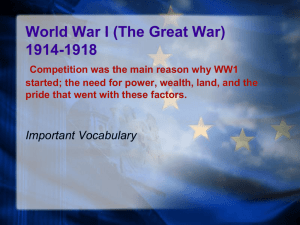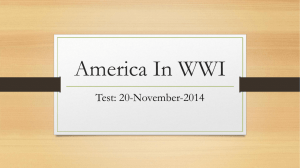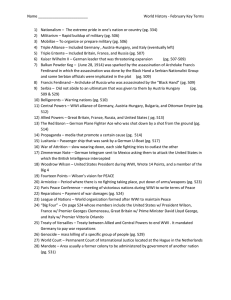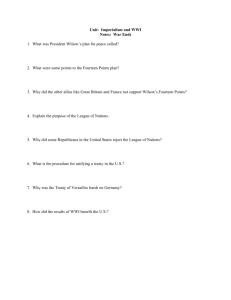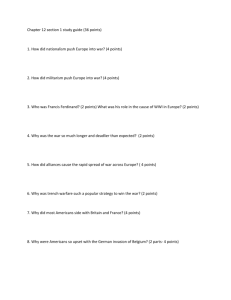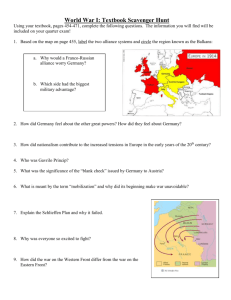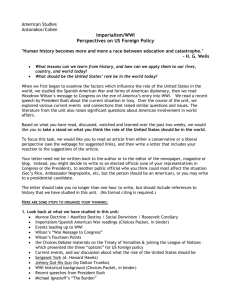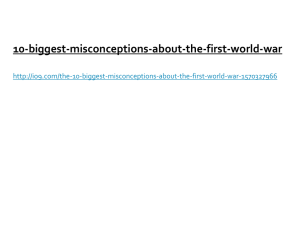Wilson and WWI
advertisement
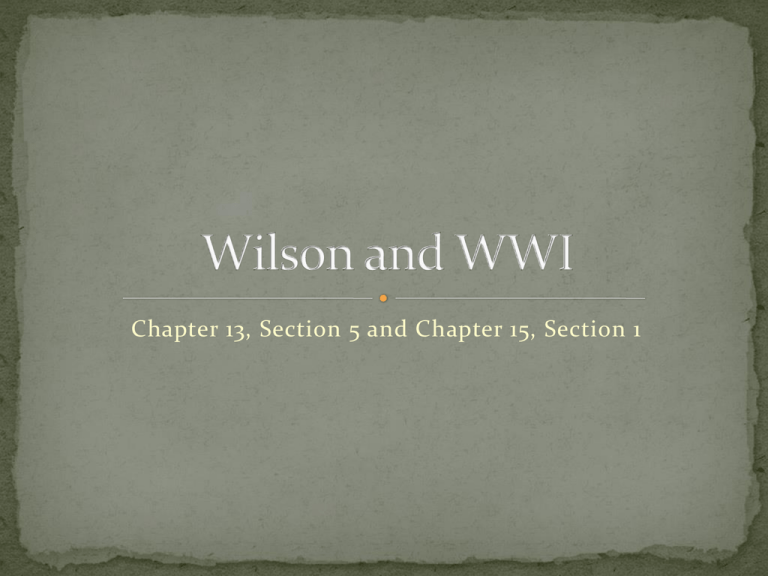
Chapter 13, Section 5 and Chapter 15, Section 1 William Taft won the Republican nomination for the election of 1912. In response, Theodore Roosevelt went and formed his own party– the Bull Moose Party, and joined the race as a third-party candidate. Republicans were split over the two men, so a united Democratic Party was able to capture the White House with their candidate, Woodrow Wilson. When Wilson took office, he wanted to reignite the progressive legislation that Roosevelt had begun, and Taft had since weakened. His collective goals were known as the New Freedom because he wanted to provide new opportunities (freedom) for small businesses. He would accomplish this by putting in place strict government controls on corporations. The Progressive Era witnessed many changes in almost every facet of American society. In regards to politics, changes occurred regarding election rules and who was eligible to vote (women); Economically, regulation of big business through the establishment of gov. agencies and legislation remains to this day; Improvement in both work and housing conditions bettered the standard of living for poor workers. Chapter 15, Section 1 Causes of WWI- MAIN Militarism Alliance System Imperialism Nationalism Combined together, these four causes led to the outbreak of WWI. There were many factors that led up to the outbreak of World War One. These included imperialism, militarism, and an alliance system that spread across Europe. Imperialism, the control of smaller countries by larger ones, intensified with the spread of Social Darwinism. After France had lost territory in the region of Alsace-Lorraine to the Germans, they saw this as a mark against their strength or ‘fit’-ness. This also hurt France’s nationalistic pride. Militarism, or glorification of the military, was fueled by the spread of imperialism across the globe. Germany had soon amassed one of the largest collections of weapons in the world. This fear led to an arms race– a build-up of military technology within a country. It was only a matter of time before tensions boiled over. When they did, the ‘sides’ had already been drawn thanks to the alliance system. Under this, a country knew that if they were consumed by war, its fellow allies would jump in to back them up. Europe had been divided into two powerful alliances: the Triple Alliance and the Triple Entente. The Triple Alliance originally consisted of Germany, Austria-Hungary and Italy. (Italy later left) The Triple Entente consisted of France, Russia and Great Britain. While these three contributed to the outbreak of WWI, they were both relatively long-term causes (ones that had been building over the years). The ‘spark’ that kicked off WWI was the assassination of archduke Francis Ferdinand of Austria-Hungary and his wife. The archduke and his wife were shot by a Serbian, who believed that Bosnia should still belong to Serbia and not Austria-Hungary. When archduke Francis Ferdinand was assassinated by a Serbian extremist, Austria-Hungary declared war on Serbia. Germany pledged to support its ally, Austria-Hungary, and Russia pledged to support Serbia. When Germany invaded neutral Belgium and looked to attack France, Great Britain pledged to protect its ally. All of the fighting in Europe spread because of the alliance system. Although fighting during WWI took place in the Middle East, Eastern Europe and Italy, the Western Front became the main stage for conflict. It was located along the border between France and Belgium. New military technologies were showcased during WWI for the first time, including: Machine guns; Poison gas; Submarines; Tanks; Airplanes Due to the complexity of ethnic layers found in the United States (i.e. ‘melting pot’), Wilson wanted the U.S. to remain neutral in the European conflict for as long as possible. He was afraid that having Americans choose sides would tear the country apart. The diverse opinions of the American people somewhat solidified as Germany invaded neutral Belgium. These opinions were: isolationists, interventionists and internationalists. Isolationists: believed that the war was none of the U.S.’ business, and they should not get involved at all, isolating itself from the fighting. Interventionists: since the war affected American interests (specifically trade), the U.S. should enter the conflict and side with the Allies. Internationalists: believed that the U.S. should play an active role in world affairs and work toward negotiating a peace, but NOT enter the war. As Wilson ran for re-election in 1916, he promoted himself with the slogan “He kept us out of war.” Although the election was close, Wilson did win reelection. The U.S. would not stay out of war for much longer, though. Actions by Germany forced the U.S. to enter the war. As Germany blockaded Britain, they used their submarines to attack any ships that attempted to bring war supplies for aid. The U.S. passenger ship Lusitania was sunk by one of these submarines, carrying 159 Americans on May 7th, 1915. Although the sinking of the Lusitania angered Americans, it still did not prompt war. It was not until almost 2 years later, in January of 1917 when the United States intercepted a telegram from Germany to Mexico. This telegram became known as the Zimmerman note. In it, the German Foreign Minister pledged the return of lands lost in the Mexican-American War to Mexico if Mexico declared war on the United States. Shortly after, the United States declared war on Germany, officially on April 6th, 1917.
